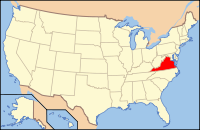Standardville, Virginia
| Orange County, Virginia | ||
|---|---|---|

Orange County Courthouse
|
||
|
||
 Location in the U.S. state of Virginia |
||
 Virginia's location in the U.S. |
||
| Founded | 1734 | |
| Named for | Prince William III of Orange | |
| Seat | Orange | |
| Largest town | Orange | |
| Area | ||
| • Total | 343 sq mi (888 km2) | |
| • Land | 341 sq mi (883 km2) | |
| • Water | 2.5 sq mi (6 km2), 0.7% | |
| Population (est.) | ||
| • (2015) | 35,385 | |
| • Density | 103/sq mi (40/km2) | |
| Congressional district | 7th | |
| Time zone | Eastern: UTC−5/−4 | |
| Website | orangecountyva |
|
Orange County is a county located in the Central Piedmont region of the Commonwealth of Virginia. As of the 2010 census, the population was 33,481. Its county seat is Orange.
Orange County is home to Montpelier, the 2,700-acre (1,100 ha) estate of James Madison, the 4th President of the United States and oft-hailed "Father of the Constitution." The county celebrated its 275th anniversary in 2009.
The area was inhabited for thousands of years by various cultures of indigenous peoples. At the time of European encounter, the Ontponea, a sub-group of the Siouan-speaking Manahoac tribe, lived in this Piedmont area.
The first European settlement in what was to become Orange County was Germanna, formed when Governor Alexander Spotswood settled 12 immigrant families from Westphalia, Germany there in 1714; a total of 42 people. Orange County, as a legal entity, was created in August 1734 when the Virginia House of Burgesses adopted "An Act for Dividing Spotsylvania County." Unlike other counties whose boundaries had ended at the Blue Ridge Mountains, Orange was bounded on the west "by the utmost limits of Virginia" which, at that time, stretched to the Mississippi River and the Great Lakes. The colony of Virginia claimed the land, but very little of it had yet been occupied by any English. For this reason, some contend that Orange County was at one time the largest county that ever existed. This situation lasted only four years; in 1738 most of the western tract was split off into Augusta County. The expansiveness of the county boundaries was to encourage settlement further westward as well as to contend against the French claim to the Ohio Valley region.
...
Wikipedia

